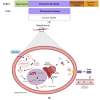Current Evidence of the Role of the Myokine Irisin in Cancer
- PMID: 34071869
- PMCID: PMC8199282
- DOI: 10.3390/cancers13112628
Current Evidence of the Role of the Myokine Irisin in Cancer
Abstract
Cancer is a disease associated with extreme human suffering, a huge economic cost to health systems, and is the second leading cause of death worldwide. Regular physical activity is associated with many health benefits, including reduced cancer risk. In the past two decades, exercising/contracting skeletal muscles have been found to secrete a wide range of biologically active proteins, named myokines. Myokines are delivered, via the circulation, to different cells/tissues, bind to their specific receptors and initiate signaling cascades mediating the health benefits of exercise. The present review summarizes the existing evidence of the role of the myokine irisin in cancer. In vitro studies have shown that the treatment of various cancer cells with irisin resulted in the inhibition of cell proliferation, survival, migration/ invasion and induced apoptosis by affecting key proliferative and antiapoptotic signaling pathways. However, the effects of irisin in humans remains unclear. Although the majority of the existing studies have found reduced serum irisin levels in cancer patients, a few studies have shown the opposite. Similarly, the majority of studies have found increased levels of irisin in cancer tissues, with a few studies showing the opposite trend. Clearly, further investigations are required to determine the exact role of irisin in cancer.
Keywords: cancer; contraction; exercise; health benefits; in vitro; in vivo; irisin; muscle; myokines.
Conflict of interest statement
The authors declare no conflict of interest.
Figures



Similar articles
-
Role of the Myokine Irisin on Bone Homeostasis: Review of the Current Evidence.Int J Mol Sci. 2021 Aug 24;22(17):9136. doi: 10.3390/ijms22179136. Int J Mol Sci. 2021. PMID: 34502045 Free PMC article. Review.
-
Multiple Roles in Neuroprotection for the Exercise Derived Myokine Irisin.Front Aging Neurosci. 2021 Apr 16;13:649929. doi: 10.3389/fnagi.2021.649929. eCollection 2021. Front Aging Neurosci. 2021. PMID: 33935687 Free PMC article. Review.
-
Effects of the exercise-inducible myokine irisin on malignant and non-malignant breast epithelial cell behavior in vitro.Int J Cancer. 2015 Feb 15;136(4):E197-202. doi: 10.1002/ijc.29142. Epub 2014 Aug 30. Int J Cancer. 2015. PMID: 25124080
-
Exercise-induced modulation of myokine irisin in bone and cartilage tissue-Positive effects on osteoarthritis: A narrative review.Front Aging Neurosci. 2022 Aug 19;14:934406. doi: 10.3389/fnagi.2022.934406. eCollection 2022. Front Aging Neurosci. 2022. PMID: 36062149 Free PMC article. Review.
-
Irisin: A New Code Uncover the Relationship of Skeletal Muscle and Cardiovascular Health During Exercise.Front Physiol. 2021 Feb 1;12:620608. doi: 10.3389/fphys.2021.620608. eCollection 2021. Front Physiol. 2021. PMID: 33597894 Free PMC article. Review.
Cited by
-
Comparative Impact of Various Exercises on Circulating Irisin in Healthy Subjects: A Systematic Review and Network Meta-Analysis.Oxid Med Cell Longev. 2022 Jul 22;2022:8235809. doi: 10.1155/2022/8235809. eCollection 2022. Oxid Med Cell Longev. 2022. PMID: 35910840 Free PMC article.
-
Role of irisin in physiology and pathology.Front Endocrinol (Lausanne). 2022 Sep 26;13:962968. doi: 10.3389/fendo.2022.962968. eCollection 2022. Front Endocrinol (Lausanne). 2022. PMID: 36225200 Free PMC article. Review.
-
Role of the Myokine Irisin on Bone Homeostasis: Review of the Current Evidence.Int J Mol Sci. 2021 Aug 24;22(17):9136. doi: 10.3390/ijms22179136. Int J Mol Sci. 2021. PMID: 34502045 Free PMC article. Review.
-
Implication of Irisin in Different Types of Cancer: A Systematic Review and Meta-Analysis.Int J Mol Sci. 2022 Sep 1;23(17):9971. doi: 10.3390/ijms23179971. Int J Mol Sci. 2022. PMID: 36077366 Free PMC article.
-
Recombinant irisin prevents cell death and mineralization defects induced by random positioning machine exposure in primary cultures of human osteoblasts: A promising strategy for the osteoporosis treatment.Front Physiol. 2023 Mar 15;14:1107933. doi: 10.3389/fphys.2023.1107933. eCollection 2023. Front Physiol. 2023. PMID: 37008023 Free PMC article.
References
Publication types
LinkOut - more resources
Full Text Sources
Medical
Miscellaneous

